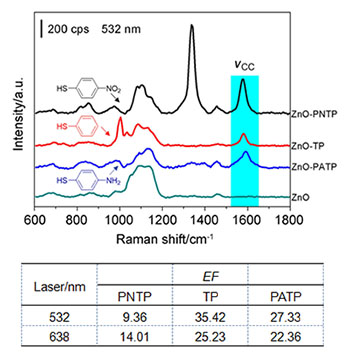| [1] Halas, N. J.; Moskovits, M. MRS Bull. 2013, 38, 607.
[2] Wang, M.; Yan, X.; Wei, D.; Liang, L.; Wang, Y. Acta Chim. Sinica 2019, 77, 184. (王猛, 闫昕, 韦德泉, 梁兰菊, 王岳平, 化学学报, 2019, 77, 184.)
[3] Kelly, K. L.; Coronado, E.; Zhao, L. L.; Schatz, G. C. J. Phys. Chem. B 2003, 107, 668.
[4] Stiles, P. L.; Dieringer, J. A.; Shah, N. C.; van Duyne, R. R. Annu. Rev. Anal. Chem. 2008, 1, 601.
[5] Halas, N. J.; Lal, S.; Chang, W. S.; Link, S.; Nordlander, P. Chem. Rev. 2011, 111, 3913.
[6] Wu, D. Y.; Liu, X. M.; Duan, S.; Xu, X.; Ren, B.; Lin, S. H.; Tian, Z. Q. J. Phys. Chem. C 2008, 112, 4195.
[7] Tian, Z. Q.; Ren, B.; Wu, D. Y. J. Phys. Chem. B 2002, 106, 9463.
[8] Zhao, L. L.; Jensen, L.; Schatz, G. C. J. Am. Chem. Soc. 2006, 128, 2911.
[9] Tian, Z. Q.; Ren, B. Annu. Rev. Phys. Chem. 2004, 55, 197.
[10] Wu, D. Y.; Li, J. F.; Ren, B.; Tian, Z. Q. Chem. Soc. Rev. 2008, 37, 1025.
[11] Wang, Y. F.; Ruan, W. D.; Zhang, J. H.; Yang, B.; Xu, W. Q.; Zhao, B.; Lombardi, J. R. J. Raman Spectrosc. 2009, 40, 1072.
[12] Klingshirn, C.; Fallert, J.; Zhou, H.; Sartor, J.; Thiele, C.; Maier Flaig, F.; Schneider, D.; Kalt, H. Phys. Status Solidi B 2010, 247, 1424.
[13] Yang, P. D.; Yan, R. X.; Fardy, M. Nano Lett. 2010, 10, 1529.
[14] Chu, S.; Wang, G. P.; Zhou, W. H.; Lin, Y. Q.; Chernyak, L.; Zhao, J. Z.; Kong, J. Y.; Li, L.; Ren, J. J.; Liu, J. L. Nat. Nanotechnol. 2011, 6, 506.
[15] Zhao, D.; Zhang, X. X.; Dong, H. B.; Yang, L. J.; Zeng, Q. S.; Li, J. Z.; Cai, L.; Zhang, X.; Luan, P. S.; Zhang, Q.; Tu, M.; Wang, S.; Zhou, W. Y.; Xie, S. S. Nanoscale 2013, 5, 4443.
[16] Dorfman, A.; Kumar, N.; Hahm, J. Langmuir 2006, 22, 4890.
[17] Wen, H.; He, T. J.; Xu, C. Y.; Zuo, J.; Liu, F. C. Mol. Phys. 1996, 88, 281.
[18] Sun, Z. H.; Zhao, B.; Lombardi, J. R. Appl. Phys. Lett. 2007, 91, 221106.
[19] Wang, X. T.; Shi, W. X.; Jin, Z.; Huang, W. F.; Lin, J.; Ma, G. S.; Li, S. Z.; Guo, L. Angew. Chem., Int. Ed. 2017, 56, 9851.
[20] Lin, J.; Shang, Y.; Li, X. X.; Yu, J.; Wang, X. T.; Guo, L. Adv. Mater. 2016, 29, 1.
[21] Yang, L. B.; Jiang, X.; Ruan, W. D.; Zhao, B.; Xu, W. Q.; Lombardi, J. R. J. Phys. Chem. C 2008, 112, 20095.
[22] Dong, B.; Fang, Y. R.; Xia, L. X.; Xu, H. X.; Sun, M. T. J. Raman Spectrosc. 2011, 42, 1205.
[23] Blum, C.; Opilik, L.; Atkin, J. M.; Braun, K.; Käemmer, S. B.; Kravtsov, V.; Kumar, N.; Lemeshko, S.; Li, J. F.; Luszcz, K.; Maleki, T.; Meixner, A. J.; Minne, S.; Raschke, M. B.; Ren, B.; Rogalski, J.; Roy, D.; Stephanidis, B.; Wang, X.; Zhang, D.; Zhong, J. H.; Zenobi, R. J. Raman Spectrosc. 2014, 45, 22.
[24] Fang, Y. R.; Li, Y. Z.; Xu, H. X.; Sun, M. T. Langmuir 2010, 26, 7737.
[25] Guo, Q. H.; Xu, M. M.; Yuan, Y. X.; Gu, R. A.; Yao, J. L. Langmuir 2016, 32, 4530.
[26] Conway, E. B.; Mathieson, J.; Dhar, P. H. J. Phys. Chem. 1974, 78, 1226.
[27] Wei, H.; Luo, J. W.; Li, S. S.; Wang, L. W. J. Am. Chem. Soc. 2016, 138, 8165.
[28] Tahir, M. N.; Natalio, F.; Cambaz, M. A.; Panthöfer, M.; Branscheid, R.; Kolb, U.; Tremel, W. Nanoscale 2013, 5, 9944. |
